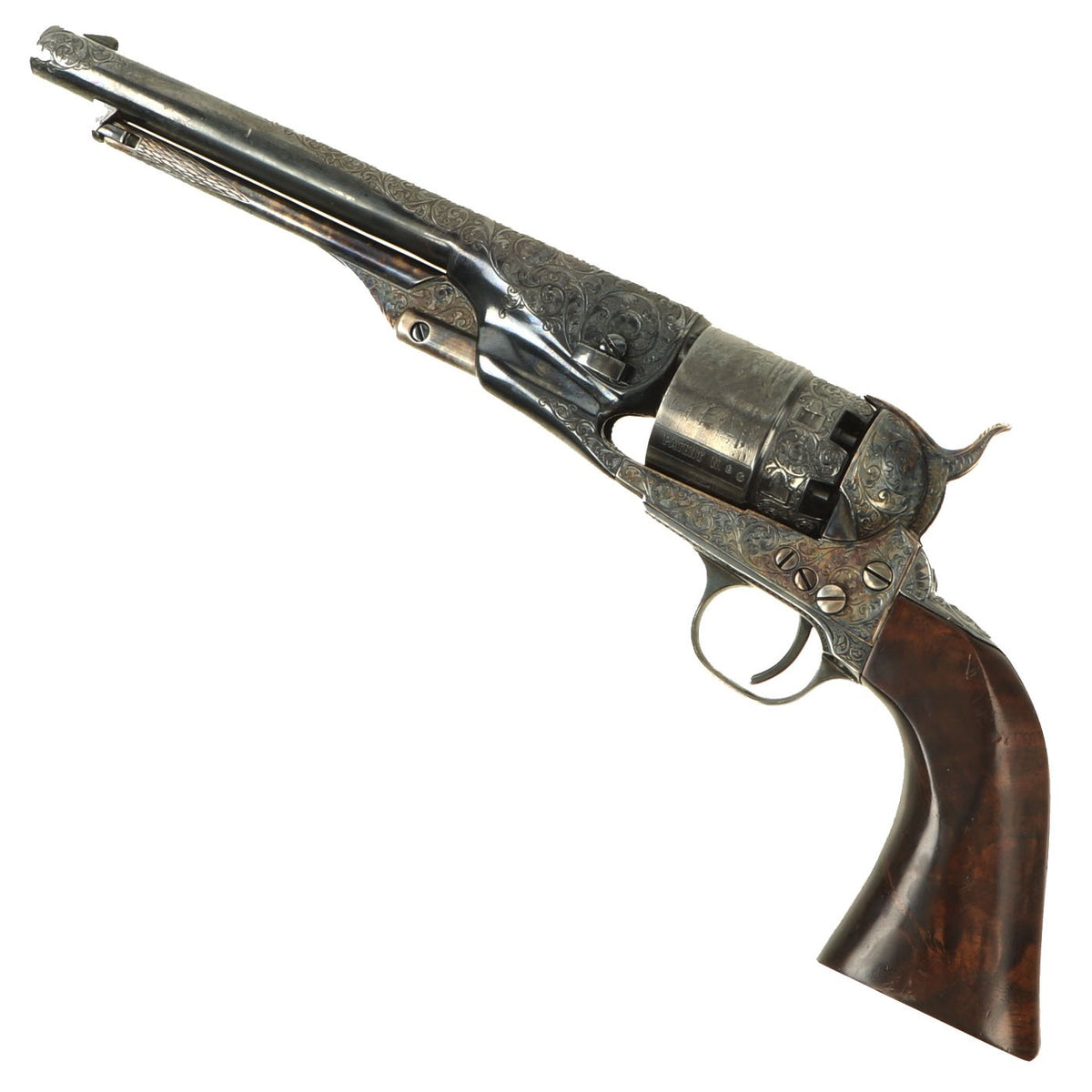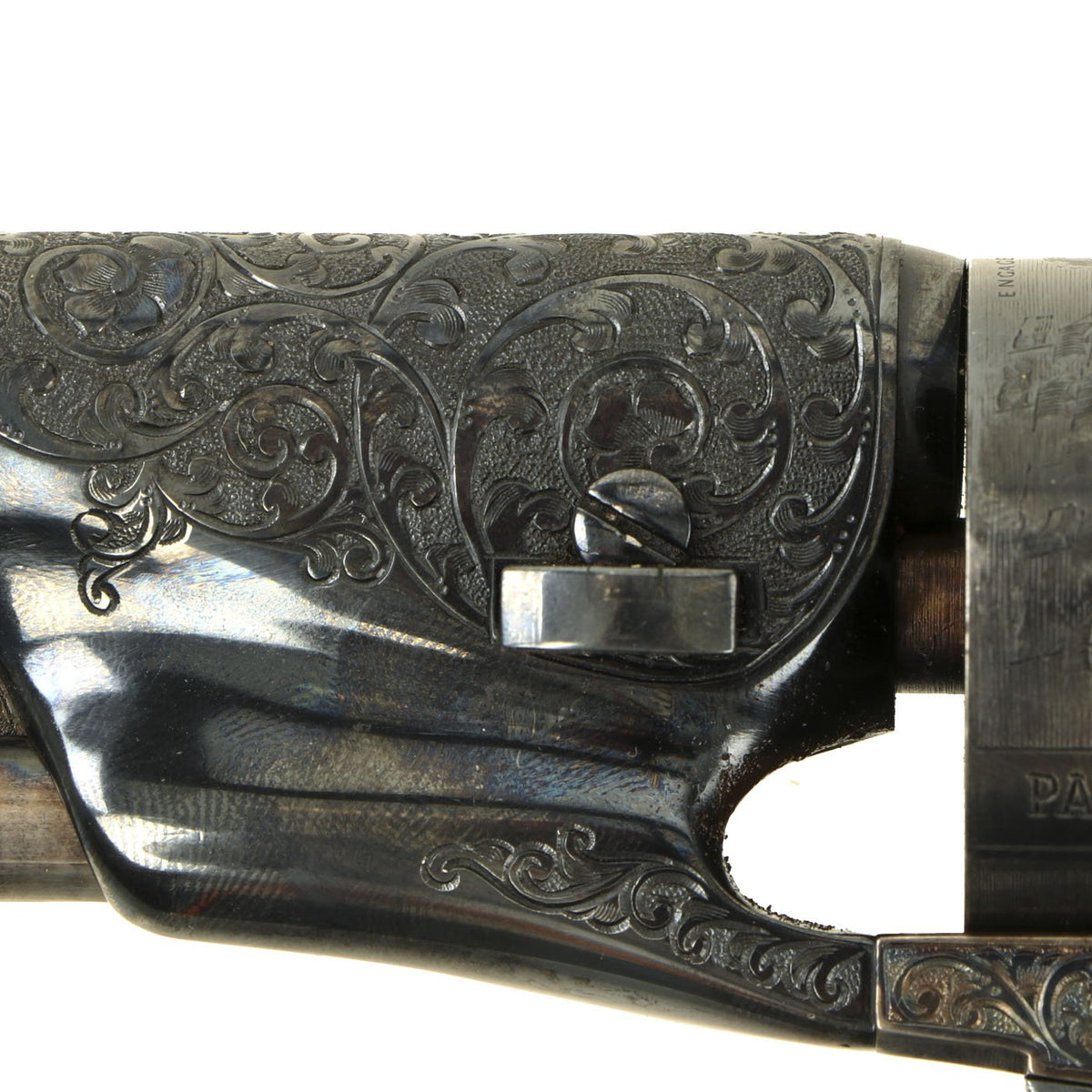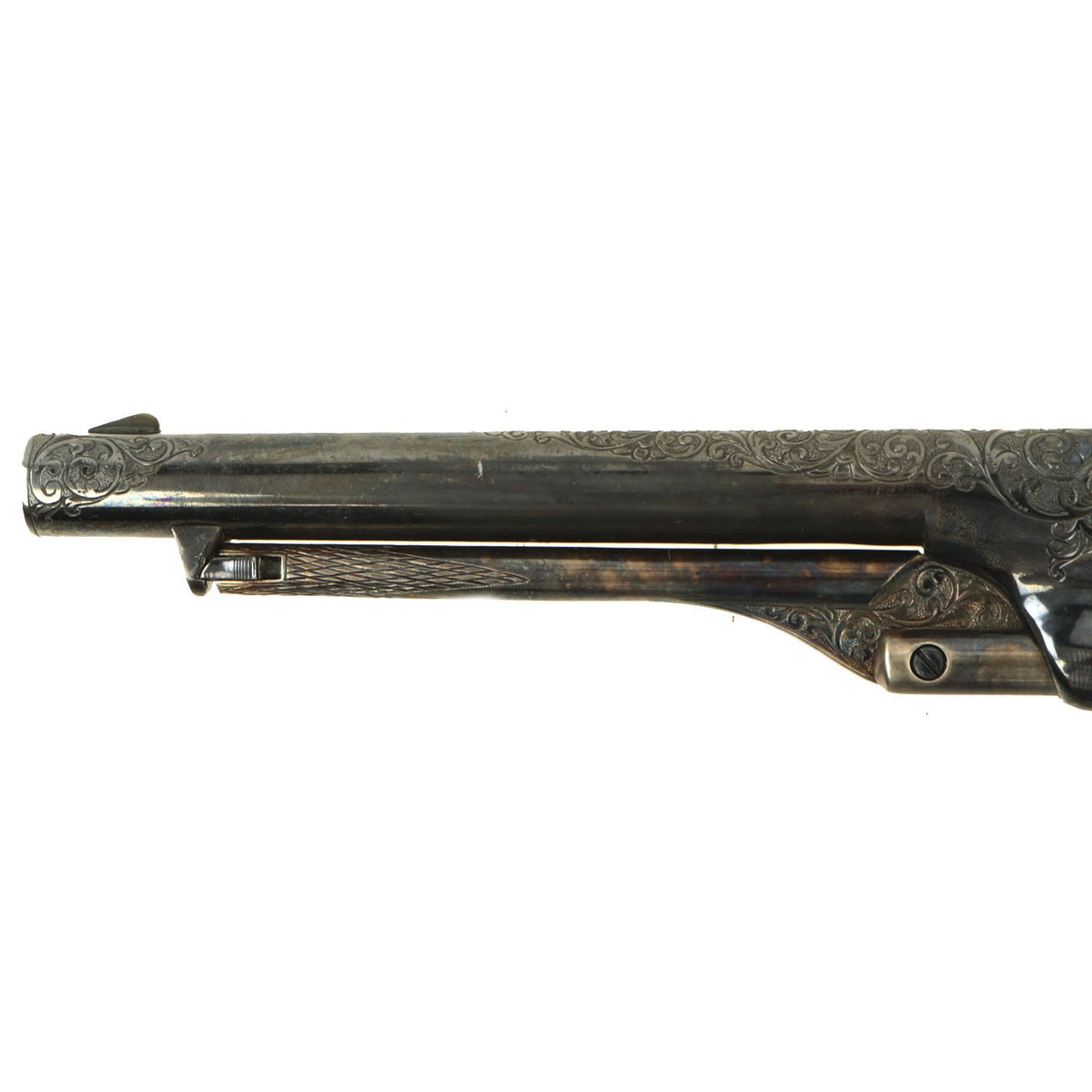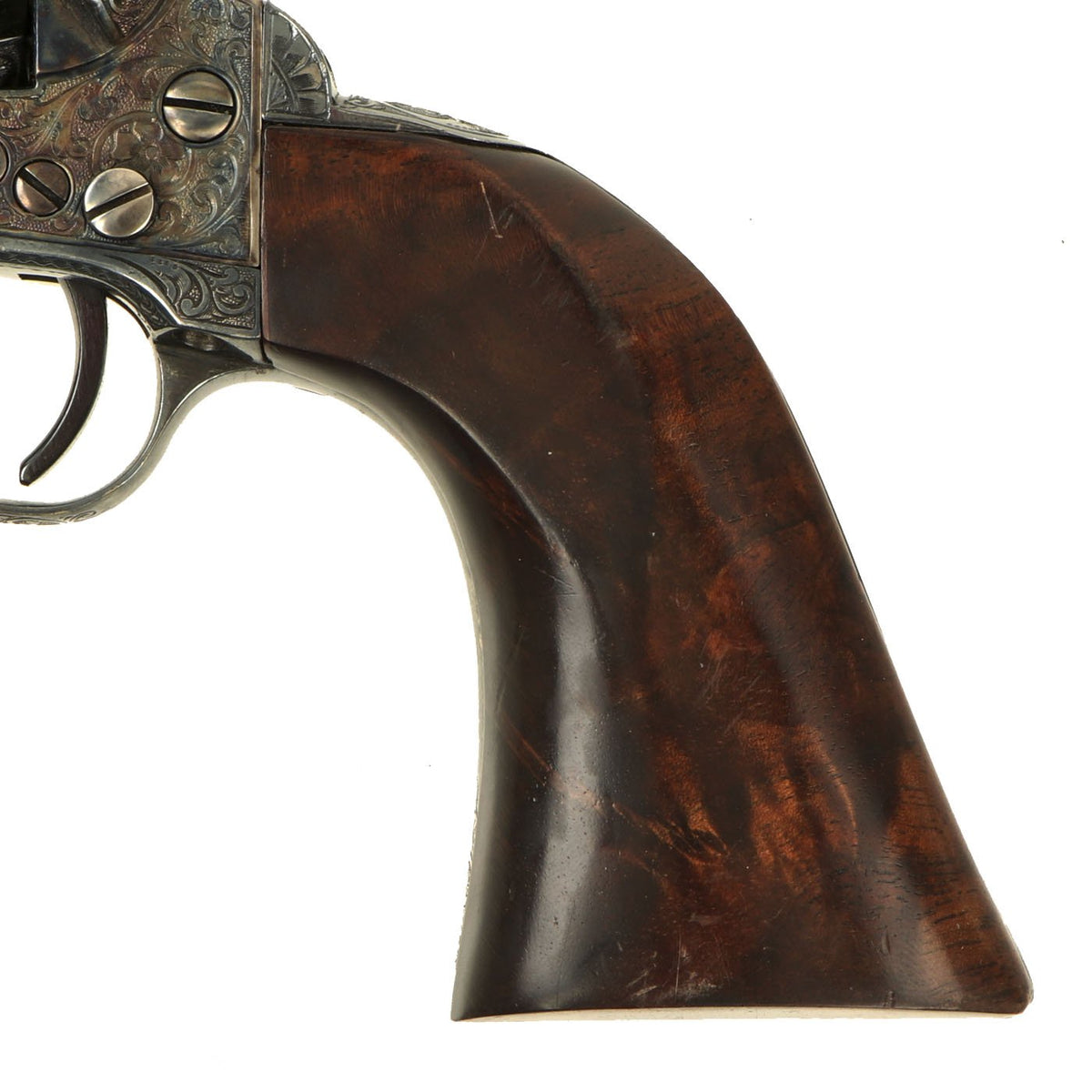High End Replica U.S. Civil War Colt Model 1860 Army Engraved “4 Screw” Percussion Revolver Original Items
$ 595,00 $ 178,50
Original Item: Only One Available. As they say, if it looks too good to be true, it probably is. This is a fantastic looking High End Replica of the Legendary Civil War issue Colt Model 1860 Army revolver, highly engraved and with a lovely case hardened and blued finish. The Model 1860 is a .44 caliber percussion, 6 shot round cylinder, 8″ barrel revolver. We are not sure which company produced this example, or when, but it is definitely high quality. It is even equipped with a four-screw frame, made to fit a shoulder stock and has the recoil shield cutouts on the frame and has the small notch in the iron buttplate.
The revolver is stamped with serial number 73307 on the barrel, cylinder axis pin, cylinder, and frame. There is also a “PATENT NO” marking on the cylinder, however the absence of “COLT” anywhere on the revolver means it was definitely not made by the company. There are however many companies producing high quality replicas of the famous revolver. It functions correctly, with a strong dry fire. The bore looks excellent, with a bright finish and crisp lands and grooves. All cap nipples are clear, though there definitely is some oxidation around the cylinder area.
We do not know which company manufactured this, and we definitely to not recommend it be used. This is a great high end replica of the classic side arm used during the U.S. Civil War, which would make an impressive display piece!
The Colt Army Model 1860 is a muzzle-loaded cap & ball .44-caliber revolver used during the American Civil War made by Colt’s Manufacturing Company. It was used as a side arm by cavalry, infantry, artillery troops, and naval forces.
The Colt 1860 Army uses the same size frame as the .36 caliber 1851 Navy revolver. The frame is relieved to allow the use of a rebated cylinder that enables the Army to be chambered in .44 caliber. the barrel on the 1860 Army has a forcing cone that is visibly shorter than that of the 1851 Navy, allowing the Army revolver to have a longer cylinder. Another distinguishing feature of the Colt 1860 Army, first introduced on the Colt 1855 Sidehammer Revolver, is the “creeping” loading lever.
More than 200,000 were manufactured from 1860 through 1873. Colt’s biggest customer was the US Government with no less than 129,730 units being purchased and issued to the troops. The weapon was a single-action, six-shot weapon accurate up to 75 to 100 yards, where the fixed sights were typically set when manufactured. The rear sight was a notch in the hammer, only usable when the revolver was fully cocked.
The Colt .44-caliber “Army” Model was the most widely used revolver of the Civil War. It had a six-shot, rotating cylinder, and fired a 0.454-inch-diameter (11.5 mm) round spherical lead ball, or a conical-tipped bullet, typically propelled by a 30-grain charge of black powder, which was ignited by a small copper percussion cap that contained a volatile charge of fulminate of mercury (a substance that explodes upon being subjected to a sharp impact). The percussion cap, when struck by the hammer, ignited the powder charge. When fired, balls had a muzzle velocity of about 900 feet per second (274 meters/second), although this depended on how much powder one loaded it with.
The unfluted cylinder was ‘rebated,’ meaning that the rear of the cylinder was turned to a smaller diameter than the front. The barrel was rounded and smoothed into the frame, as was the Navy Model. The frame, hammer, and rammer lever were case-hardened, the remainder blued; grips were of one-piece walnut; and the trigger guard and front grip strap were of brass while the backstrap was blued.”
A distinguishing feature of the Model 1860 was that its frame had no top strap, or no component running above the cylinder. Instead, its strength came from the lower frame and the massive fixed cylinder pin. This made the gun slimmer and lighter than its main competitor, the Remington Model 1858, but with a possible loss of strength. The fixed cylinder pin also meant that the barrel had to be removed in order to remove the cylinder, unlike the Model 1858, which only required you to remove the cylinder retaining pin.
History
By April 1861, 2,230 of Colt’s earliest production went to dealers south of the Mason-Dixon line. The United States Navy ordered 900 fluted cylinder revolvers in May 1861 later issued to ships enforcing the Atlantic and Gulf blockade. United States Army orders also began in May, and 127,157 had been delivered before a 5 October 1864 fire put Colt’s factory out of operation for the duration of hostilities.
Operation
Loading is a somewhat lengthy process, with each of the six chambers drilled into the revolving cylinder being loaded from the front, or “muzzle” end. A measured amount of black powder is poured into a chamber. Next a lead ball is placed at the opening of the chamber and seated by firmly pressing it in with the pivoting loading lever which is attached beneath the barrel of the revolver. For sealing each chamber, an over-size 0.454-inch-diameter (11.5 mm) lead ball is trimmed slightly by the rim of the chamber as the rammer forces it inside. Cap and ball shooters also often place a lubricated wad between balls and powder, or, alternatively, pack lard or a commercially-sold bore lubricant at the mouth of each chamber in an attempt to prevent powder in an adjacent chamber from being ignited by when the gun is fired, which is known as a chainfire.
When the Colt Model 1860 was used by 19th century soldiers, they most often loaded the gun using paper cartridges. These cartridges consisted of a pre-measured load of black powder and a ball, wrapped in nitrated paper (paper that had been soaked in potassium nitrate and then dried, to make it more flammable). To load each chamber, one only had to slip the cartridge into the front of the chamber and seat the ball with the loading lever ram. Then a percussion cap was placed onto the raised aperture, called a nipple, at the back end of the chamber.
The Colt 1860 cost approximately $20 per revolver. This was rather expensive during the 1860s, both for the United States Army and private citizens. Colt had been criticized by this high price, and by 1865 the revolver was reduced to $14.50.
The Colt “Army” revolver is to be distinguished from the Colt “Navy” revolver of which there were two models, the octagonal barrel Model 1851 Navy, and the round-barreled Model 1861 Navy, both Navy models being in the smaller .36-caliber.
Specifications:
Year of Manufacture: Recent
Caliber: .44cal
Ammunition Type: Percussion Cap and Ball
Barrel Length: 8 inches
Overall Length: 14 inches
Action: Single
Feed System: 6 Shot Revolver
Prompt Shipping and Professional Packaging
We provide a variety of shipping options due to our long-running partnerships with UPS, FedEx and DHL. Our warehouse personnel are well trained and will pack the goods according to our exact and precise specifications. Before shipping your items will be thoroughly inspected and secured. Every day, we deliver to thousands of customers in different countries. This is a sign of our determination to become the largest online retailer worldwide. Both Europe as well as the USA have warehouses and distribution centers.
Note that orders containing more than one item will be subject to a processing period that is based to the particular item.
Prior to shipping the items, our staff will carry out an exhaustive inspection of the products you ordered. Today, most orders will be delivered within 48 hours. The estimated delivery time is between 3-7 days.
Returns
The stock is constantly changing. It's not entirely managed by us since we are involved with multiple entities, including the factory and our storage. Therefore, the actual inventory could alter at any time. It is possible that you will not receive your order after the order has been made.
The period of time is 30 days. Unfortunately, if 30 days have passed since you purchased your product, we are unable to provide a refund or exchange.
The item must not be in use and must be in the original packaging. The item must be in the original packaging.
Related products
Uncategorized
Uncategorized
Uncategorized
Uncategorized
Uncategorized
Armoured Fighting Vehicles of the World: AFVs of World War One (Hardcover Book) New Made Items
Uncategorized
Uncategorized
Uncategorized
Angolan Rebel 1970s era 60mm Inert Display Mortar from Angolan Civil War Original Items
Uncategorized
Uncategorized
Uncategorized
Uncategorized
Uncategorized
Armored Burgonet Helmet & Polearm from Scottish Castle Leith Hall Circa 1700 Original Items
Uncategorized
Uncategorized
Australian WWII Owen MK1 Machine Carbine SMG Custom Fabricated Replica with Sling Original Items
Uncategorized
Uncategorized
Uncategorized












































































